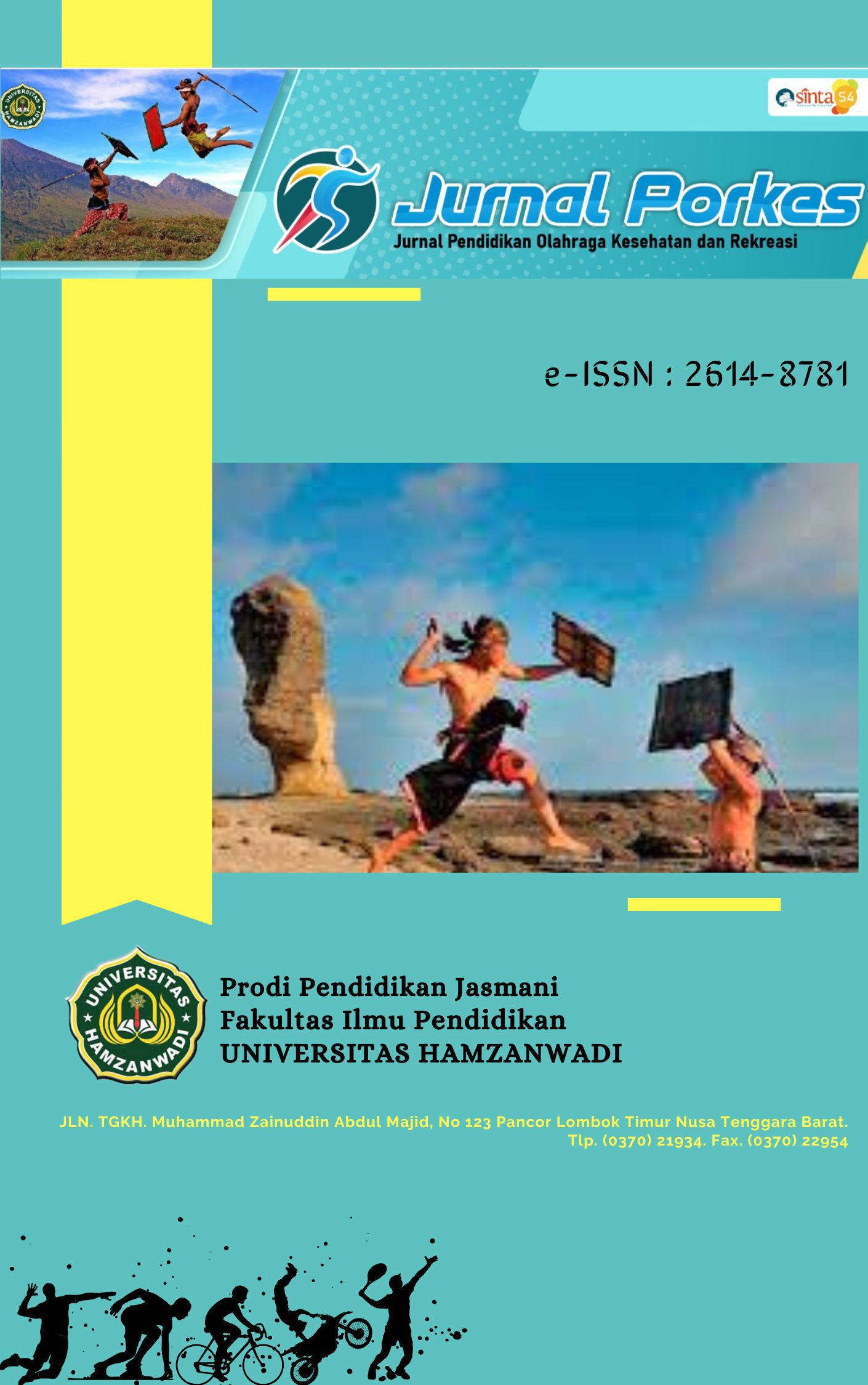Pengembangan Model Latihan Permainan Kata (Jurus) pada Cabang Olahraga Karate
DOI:
https://doi.org/10.29408/porkes.v8i2.30645Keywords:
Karate; kata; training model; motivation; game.Abstract
This study aims to develop a kata training model in karate through game-based methods to enhance technical skills, motivation, and self-confidence among beginner athletes (kohai). Based on observations and questionnaires conducted at INKANAS Dojo in Donggala Regency, several issues were identified such as low athlete motivation, monotonous training routines, and lack of engaging learning methods. To address these challenges, the researcher designed a structured and enjoyable game-based training model tailored for children aged 8–13 years. This research employed a Research and Development (R&D) approach, adapting the eight-step development model by Borg and Gall. Validation was conducted by subject matter, media, and game experts, while product trials involved a total of 24 kohai in small and large-scale testing. Results showed high feasibility and effectiveness, with an average validity score of 93.33%, motivation improvement of 96%, and kata technique mastery reaching 92%. The developed model enriches training variation and significantly improves karate learning quality. The resulting training guidebook can be widely used by coaches across dojos as an applicable and fun training tool, supporting the holistic development of athletes' character and skills.
References
Arikunto, S. (2022). Prosedur Penelitian: Suatu Pendekatan Praktik. Rineka Cipta.
Asnaldi, A. (2019). Kontribusi Motor Ability dan Konsentrasi Terhadap Kemampuan Penguasaan Kata Heian Yodan Karateka Lemkari Dojo Angkasa Lanud Padang. Jurnal Menssana, 4(1), 17–29. https://doi.org/10.24036/jm.v4i1.30
Borg, W. R & Gall, M. D (1983). Eucation Research: an Introduction.4th Edition. New York: Longman Inc
Borg, W. R., & Gall, M. D. (2003). Educational research: An introduction. British Journal of Educational Studies, 32(3). 274-274. https://philpapers.org/rec/BORERA-2
Cholik, C. A. (2021). Perkembangan Teknologi Informasi Komunikasi / ICT dalam Berbagai Bidang. Jurnal Fakultas Teknik, 2(2), 1–13. https://jurnal.unisa.ac.id/index.php/jft/article/view/83
Eloi, A. C. (2019). Karate as a Tool for Cognitive and Emotional Development. Journal of Martial Arts Studies, 6(2), 34–45.
Gall, M. D., Gall, J. P., & Borg, W. R. (2007). Educational Research, An Introduction (Eighth Edt). Pearson Education, Inc.
Gunawan, G., & Rejeki, H. S. (2022). Pengembangan Model Latihan Fisik Olahraga Karate Berbasis Profil Biomotorik Atlet. Tadulako Journal Sport Sciences and Physical Education, 10(1), 28–33. https://www.jurnalfkipuntad.com/index.php/tjsspe/article/view/2004
Hakim, H., Ishak, M., & Awaluddin, A. (2025). Pendekatan Game dalam Program Latihan untuk Meningkatkan Passing Bawah Atlet Bola Voli. Jurnal Keolahragaan Juara, 5(8), 252–262. https://e-journal.upr.ac.id/index.php/juara/article/view/22160
Kirkham, K. (2021). Exploring the Benefits of Martial Arts for Children: A Focus on Karate Training. International Journal of Physical Education and Sports, 5(4), 49–62.
Lemes, V. B., Gaya, A. R., Mota, J. & Brand, C. (2025). Self-Perceived Physical Fitness and Occurrences of Individual Levels of Autistic Traits in Adolescents: a Cluster Association Study. BMC Psychiatry Journal. 25(14), 55–68. https://link.springer.com/article/10.1186/s12888-024-06440-5
Leite, L. L., & others. (2018). Motor Skill Development through Martial Arts Practice: Insights from Karate Training. Journal of Physical Activity and Health, 15(8), 711–718. https://doi.org/10.1123/jpah.2017-0229
Maksum, A. (2018). Olahraga Bermutu Untuk Semua Makalah disampaikan dalam Pekan Ilmiah Keolahragaan 2018. Pascasarjana Universitas Negeri Surabaya, pada tanggal 17-20 September 2018 di Universitas Negeri Surabaya.
Manuputty, C. O., Fenanlampir, A., & Tahapary, J. M. (2023). The Effect of Speed Agility Quickness (SAQ) Training on Ushiro Mawasih’s Kick Speed in Kanas Karate Athletes Dojo Red-Land Halong. Jurnal Ilmiah Wahana Pendidikan, 9(5), 646–655. https://www.jurnal.peneliti.net/index.php/JIWP/article/view/4027
Masra, R., Salem, V. E. T., Polii, M. G. M., Santie, Y. D. A., Wisudariani, N. M. R., Sarwandi, S., Sari, R. P., Yuliantika, R., Nasar, A., Yenita, Y., & Santiari, N. P. L. (2023). Research & Development dalam pendidikan (M. Jannah (ed.); Ed.I). PT. Mifandi Mandiri Digital.
Mulyatiningsih, E. (2011). Pengembangan Instrumen Penelitian. UNY Press.
Purba, P. H., Rahayu, T., Kusuma, D. W. Y., & Handayani, O. W. K. (2023). Tes dan Pengukuran Kondisi Fisik Karateka Junior Kategori Kata (Ed. I). Zahira Media Publisher CV. ZT Corpora.
Rohman, U. (2018). Profil Kompetensi Pelatih Sepakbola Usia Dini. Journal Sport Area, 3(2), 179–190. https://doi.org/10.25299/sportarea.2018.vol3(2).2161
Sasmarianto, S., & Henmi, M. A. (2024). Tingkat Kondisi Fisik Atlet Karate Inkai Kota Pekanbaru. Integrated Sport Journal, 2(2), 18–30.
https://www.ejournal.indrainstitute.id/index.php/isj/article/view/793
Srianto, W., & Purwanto, S. (2014a). Pengembangan Model Latihan Karate Kids pada Anak Usia Sekolah Dasar Kelas Atas. Jurnal Keolahragaan.
Srianto, W., & Purwanto, S. (2014b). Pengembangan Model Latihan Karate Kids pada Anak Usia Sekolah Dasar Kelas Atas. Jurnal Keolahragaan, 2(2), 228–240. https://doi.org/10.21831/jk.v2i2.2628
Sugiyono. (2016). Metode Penelitian dan Pengembangan: Research and Development. Alfabeta.
Sugiyono. (2017). Metode Penelitian Pendidikan. Alfabeta.
Sukmadinata, N. S. (2005). Metode Penelitian Pendidikan. Remaja Rosdakarya.
Susila, G. H. A. (2018). Pengembangan Model Latihan Permainan Pertarungan (Kumite) Pada Cabang Olahraga Karate. Jurnal Pendidikan Kesehatan Rekreasi, 4(1), 1–9. https://ojs.mahadewa.ac.id/index.php/jpkr/article/view/123
Downloads
Published
How to Cite
Issue
Section
License
Copyright (c) 2025 A. Risky Kirana Senani, Didik Purwanto, Hendriana Sri Rejeki

This work is licensed under a Creative Commons Attribution-ShareAlike 4.0 International License.
![]()
Jurnal Porkes is licensed under a Creative Commons Attribution-Share Alike 4.0 International License







